Yeohelmetguy
Well-known member
This is my fourth post on the Forum highlighting the British dragoon/cavalry helmets that make up my collection. In this post I am highlighting the two “Queen’s Own Royal Staffordshire Yeomanry” helmets. The “Queen’s Own Royal Staffordshire Yeomanry” adopted the 1847 or Albert pattern dragoon helmet in 1860. The helmet, unlike most other cavalry regiments that wore the 1847/Albert pattern helmet in silver/German silver or gilt/brass, their metal helmet was japanned black with silver metal fittings. From 1860 to 1870 the displayed a black plume which was then changed to white and worn as such from 1870 through 1873. My two helmets, aside from the obvious difference in the plumes appear to be identical, however there are subtle differences like the size and style of the rose style ear rosettes that support the silver chin chain. In the earlier helmet with the black plume the ear rosettes are of a slightly smaller diameter than the white plume later pattern helmet. The attachment of the chin chain, however, remained the same being attached to the rosettes via hooks affixed at the bottom of the rosettes and not by a screw attached to the back of the ear rosettes which is common among other regiments helmets.
The Staffordshire Regiment was formed on 4 July 1794, the first commanding officer being Colonel George G. L. Gower, 1st Duke od Sutherland. The regiment, originally titled The Staffordshire Regiment of Gentlemen and Yeomanry, a part-time cavalry unit numbering about 300 men was divided into troops associated with the Staffordshire towns of Newcastle-under-Lyme, Stafford, Lichfield, Leek and Walsall. The uniform of the regiment was: a red jacket with yellow facings, white waistcoat, white leather breeches and boots. As their headdress the regiment wore a Tarleton style helmet with bearskin crest and a red over white feather plume at the side and were armed with a sword and pistol. The regimental motto was "Pro Aris et Focis" (Hearth and Home) and the badge was the Staffordshire Knot. The regiment was first called into service in 1795 in order to support the civil powers in suppressing the Bread Riots. Future Prime Minister Robert Peel was an officer in the Staffordshire Yeomanry Cavalry in 1820.
As a result of its valuable service to the Crown, in 1838 Queen Victoria bestowed the title “Royal” with the regiment being known going forward as the “Queen’s Own Royal Staffordshire Yeomanry. In 1842, the regiment was embodied for 6 weeks when riots again broke out in the county. As a result of that service, the regiment was presented with 12 silver trumpets inscribed "Presented by a grateful County to the Queen's Own Royal Staffordshire Yeomanry for their services in 1842. The Staffordshire Regiment adopted the 1847 Albert pattern helmet in 1860 and unique among cavalry regiments as their helmet was Japanned black. By 1875, the regiment had expanded to 12 Troops with headquarters at Lichfield. The strength on 1 December 1875 was stated to be 495 with 104 wanting to complete. At this point, the uniform was blue with scarlet facing and silver lace.
The Yeomanry was not intended to serve overseas, but due to the string of defeats during the “Black Week” in December 1899, the British government realized they were going to need more troops than just the regular army. A Royal Warrant was issued on 24 December 1899 to allow volunteer forces to serve in the Second Boer War. The Royal Warrant asked standing Yeomanry regiments to provide service companies of approximately 115 men each for the Imperial Yeomanry. The Queen’s Own Royal Staffordshire Yeomanry Cavalry regiment provided the 6th (Staffordshire) Company for the 4th Battalion, Imperial Yeomanry in 1900 and the 106th (Staffordshire) Company for the same battalion in 1901. The regiment moved to Tamworth Street in Lichfield (since demolished) in 1905 and then to Friar’s Walk (off Bailey Street) in Stafford in 1914.
I hope everyone will enjoy the brief history of the Queen’s Own Royal Staffordshire Yeomanry regiment covering the period the regiment wore the two helmets in this post and of course the helmets themselves. Please feel free to post any comments!
Best regards,
David
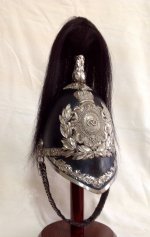
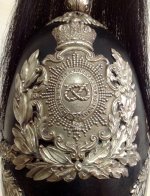
Queen's Own Royal Staffordshire Yeomanry Cavalry helmet 1860-1870
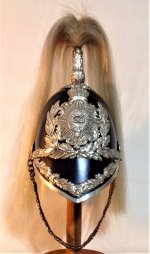
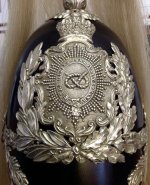
Queen's Own Royal Staffordshire Yeomanry Cavalry helmet as worn 1870-1873
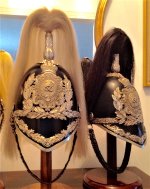
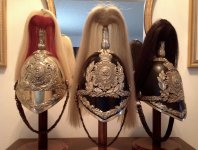
The Staffordshire Regiment was formed on 4 July 1794, the first commanding officer being Colonel George G. L. Gower, 1st Duke od Sutherland. The regiment, originally titled The Staffordshire Regiment of Gentlemen and Yeomanry, a part-time cavalry unit numbering about 300 men was divided into troops associated with the Staffordshire towns of Newcastle-under-Lyme, Stafford, Lichfield, Leek and Walsall. The uniform of the regiment was: a red jacket with yellow facings, white waistcoat, white leather breeches and boots. As their headdress the regiment wore a Tarleton style helmet with bearskin crest and a red over white feather plume at the side and were armed with a sword and pistol. The regimental motto was "Pro Aris et Focis" (Hearth and Home) and the badge was the Staffordshire Knot. The regiment was first called into service in 1795 in order to support the civil powers in suppressing the Bread Riots. Future Prime Minister Robert Peel was an officer in the Staffordshire Yeomanry Cavalry in 1820.
As a result of its valuable service to the Crown, in 1838 Queen Victoria bestowed the title “Royal” with the regiment being known going forward as the “Queen’s Own Royal Staffordshire Yeomanry. In 1842, the regiment was embodied for 6 weeks when riots again broke out in the county. As a result of that service, the regiment was presented with 12 silver trumpets inscribed "Presented by a grateful County to the Queen's Own Royal Staffordshire Yeomanry for their services in 1842. The Staffordshire Regiment adopted the 1847 Albert pattern helmet in 1860 and unique among cavalry regiments as their helmet was Japanned black. By 1875, the regiment had expanded to 12 Troops with headquarters at Lichfield. The strength on 1 December 1875 was stated to be 495 with 104 wanting to complete. At this point, the uniform was blue with scarlet facing and silver lace.
The Yeomanry was not intended to serve overseas, but due to the string of defeats during the “Black Week” in December 1899, the British government realized they were going to need more troops than just the regular army. A Royal Warrant was issued on 24 December 1899 to allow volunteer forces to serve in the Second Boer War. The Royal Warrant asked standing Yeomanry regiments to provide service companies of approximately 115 men each for the Imperial Yeomanry. The Queen’s Own Royal Staffordshire Yeomanry Cavalry regiment provided the 6th (Staffordshire) Company for the 4th Battalion, Imperial Yeomanry in 1900 and the 106th (Staffordshire) Company for the same battalion in 1901. The regiment moved to Tamworth Street in Lichfield (since demolished) in 1905 and then to Friar’s Walk (off Bailey Street) in Stafford in 1914.
I hope everyone will enjoy the brief history of the Queen’s Own Royal Staffordshire Yeomanry regiment covering the period the regiment wore the two helmets in this post and of course the helmets themselves. Please feel free to post any comments!
Best regards,
David


Queen's Own Royal Staffordshire Yeomanry Cavalry helmet 1860-1870


Queen's Own Royal Staffordshire Yeomanry Cavalry helmet as worn 1870-1873


